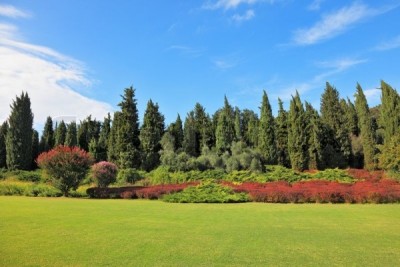05 Feb Ways to Reduce Winter Damage to Your Landscape
The temperatures have fallen and it’s a little uncomfortable to be outside gardening right now. We humans have the luxury of staying indoors to shelter ourselves from the elements but those beautiful plants you installed, on the other hand, have no such refuge. Many plantings in our area turn dormant in the colder months as a way to hunker down and survive the cold season. Other trees and bushes such as Evergreens, particularly broad leafed varieties, keep their leaves/foliage throughout the year and stand a long, lonely vigil throughout the cold, harsh winter. Because of this, Coniferous plantings are highly susceptible to a type of damage known as Winterburn. We want to share tips to help reduce winter damage.
Winterburn, also known as desiccation, works like this: A plant pulls moisture from the soil, drawing it through its system, using what it needs. It then releases the majority of that moisture as vapor through its leaves. This process (transpiration) works like a siphon, and is continuous. That is, until the ground freezes and any usable groundwater is rendered unobtainable. Coniferous plantings will continue to expel moisture through its leaves even though this water cannot be replenished and become dehydrated. The combination of frigid temperatures, ravaging winter sun and high winds will cause these dehydrated leaves to significantly dry out, or “burn”. Generally, Winterburn damage is aesthetic and will the plant will regenerate over time but with newly planted or partially-established plants this damage could be a death sentence. More mature, established plantings are less likely to suffer from, but not completely immune to Winterburn. What can be done to decrease the severity of Winterburn damage? The application of anti-desiccants are a great way to help protect your coniferous plantings when the proper considerations have been made prior to application such as, choosing appropriate plantings for your area and ensuring you plant them in ideal growing locations on your property. You will also want to perform regular watering after the growing season has ended to ensure your plantings are well hydrated going into the cold season. What is an anti-desiccant? An anti-desiccant (also known as an anti-transpirant) is a compound applied to your plants that coats them and inhibits moisture loss through pores in the leaves. Some products are chemical compounds, others are derived from pine oils and all are biodegradable by design. When are anti-desiccants applied? In Northern Virginia (USDA Hardiness Zone 6) you can apply anti-desiccants on days when temperatures are in the 40 & 50 degree ranges and it is consistently approaching frost at night. Late November into December is usually a safe bet in Northern Virginia. Depending on the number of plants you’ll be treating, these products come in small, ready-to-use (RTU) Windex-type bottles as well as concentrates that can be mixed in pressurized sprayers. Before application you’ll want to ensure the foliage of the plants that you are treating are dry and that there is no precipitation in the immediate forecast as these products will need to cure or dry to be effective. Be sure to spray both the top and bottom of the leaves since moisture is shed through both surfaces. Apply your anti-desiccant evenly and in amounts in accordance with its label. In areas with extended or extremely cold winter conditions, a second application may be necessary. If you live in an area where a second treatment is helpful, it will generally be applied on a suitable day in late January into February. Additionally, anti-desiccants are useful for applications beyond your hardy winter trees. They can also be applied to prolong the beauty of Christmas greens, as a protective measure for sensitive bud wood on hydrangeas or recently pruned rose bushes. Anti-desiccants can be used on dormant bulbs, by dipping the bulbs before planting and will even prolong your carved Jack-o-lanterns! What plants benefit from anti-desiccants? Treatment with anti-desiccant products are not ideal in every circumstance. Plantings that best benefit from anti-desiccant applications include most broad leafed evergreen plants such as Otto Luyken laurels, aucuba, skimmia, leucothoe, mahonia, boxwood, rhododendrons, even hollies and euonymus. I suggest proceeding cautiously when using anti-desiccants on fine-needled conifers such as yews and arborvitaes as these species seem to reap some benefits from the application but can be a finicky toward this treatment. I highly recommend avoiding the use of any anti-desiccant on spruce trees, blue spruce in particular, as these trees have an existing waxy coating that may be damaged by the treatment. Winter can be quite harsh on your landscape and is a particular challenge for your evergreens, broadleaf and other coniferous plantings and young or newly installed plantings are particularly susceptible to winter damages, but with a little extra attention a few times through the cold season you can greatly decrease the risk of damage. Timely and appropriate use of anti-desiccants can go a long way to giving your landscape investments a leg up in this most trying season, and a running start when the temperatures break and that glorious spring arrives.

Sorry, the comment form is closed at this time.